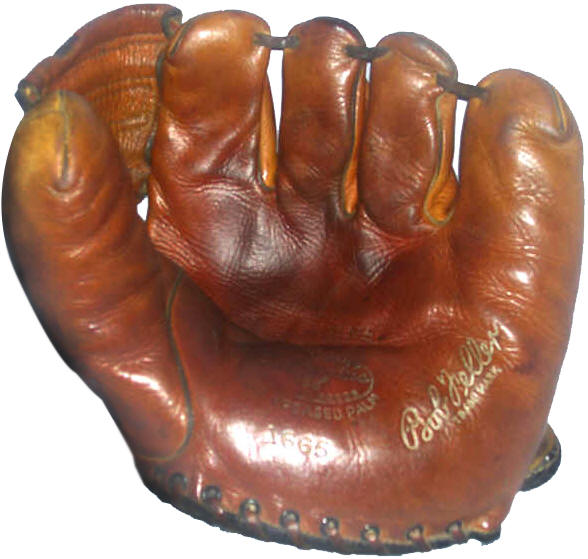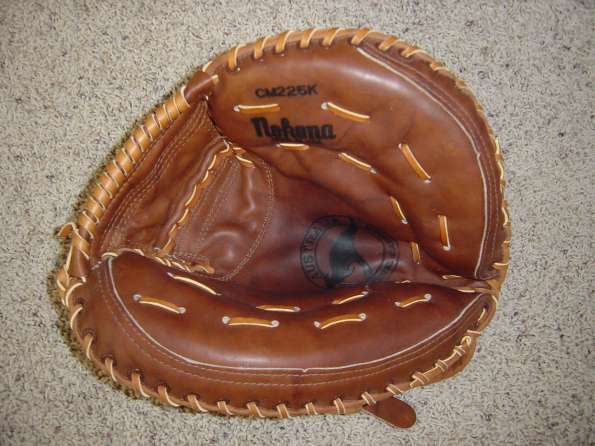The baseball glove is an item that has been around for hundreds of years. Gloves are a vital part of the game, and have been around almost as long as baseball itself. They have evolved, grown, and changed to fit different demands of the modern sport. The aesthetic of gloves has always been centered around functionality, but players always gravitate towards gloves that are good-looking. The evolution of gloves happened fast, and the aesthetic revolution continues to happen today.

The first baseball gloves looked something like this. Originally, they were just typical leather gloves that would protect the hand and add some padding from fast-moving baseballs. The players would make their own gloves, making them however they pleased. Any leather that was available was used. This often lead to gloves being poorly stitched together, beat-up, and simple.

Baseball gloves slowly added more features and more padding. Perhaps the most important part of the baseball glove slowly started to form, the “webbing.” Bound leather between the thumb and forefinger allowed for a place to catch or trap balls. This, along with the binding of the other fingers together (not shown here) slowly changed the aesthetic from regular leather gloves to a more unique and distinguishable look.

This is an early version of the look that we see in most gloves today. A padded palm to protect the wearer’s hand, full webbing in between the thumb and forefinger, and bound fingers. Gloves like this were also lose enough that they could be squeezed together, stopping the ball inside, instead of just catching it on the palm. Models like this paved the way to current gloves.

Modern gloves have branched out in to multiple categories. This is a look at an outfielder’s glove. These gloves have extra long fingering, which allow more reach for outfielders to catch balls. These have big webs and less padding, since the palm is not the place ever used to catch the ball. Outfielders typically wear their gloves very high on their hand, leaving the heel of the hand sticking out. This is different from the way other players wear their gloves.

The catchers mitt is the most unique version of the baseball glove. These gloves have the most padding of all, since catchers consistently catch high velocity pitches. The thick padding on the sides also helps keep the ball from popping out once inside. The webbing is usually tight and concise. Catchers mitts are much smaller than other gloves.

A fist baseman glove also has a unique design. The first baseman has to make different catches than any other player, so the glove is modified to reflect that. The curved edge helps to pick balls out of the dirt smoothly. It also has a very deep pocket. Notice how deep and wide the webbing is in between the thumb and forefinger. This is a special aesthetic. A symbol of pride for first baseman is how deep their pocket is. The first basemen glove is different from typical gloves.

Another new trend in baseball gloves is highly customized pieces. Players often wear gloves that have their team colors, as opposed to traditional black or brown leather. This is an exaggerated example, but players get more creative every year. It is not uncommon to have names, initials, jersey number, team names, or special colors on the glove. Gloves are becoming a fashion statement for some players. They use it as another way to look good while playing.


4 Comments. Leave new
Now a days there comes too much changes in baseball gloves. We as the youth support such games. https://www.theglovez.com/baseball/ I appreciate the article.
This is a very well written blog on the history and evolution of the baseball glove. It is very interesting to see how far the glove has come in terms of style and utility over the course of its existence. I think you could have had a substantial post just on the the gloves of today and how different positions affect the glove’s design; like middle infield positions need a smaller glove so they can transfer the ball from glove to hand quickly, outfielder gloves need to be quite a bit larger to give the fielder a couple more inches of reach, and the first baseman needs a glove that is a hybrid of a catcher’s mitt and an infielder’s mitt to give the player a balance between fielding and catching balls thrown by other infielders that typically travel 85 mph+.
I don’t know much about baseball but your post was both interesting and informative! I thought baseball gloves all had the same design: the catcher’s mitt. Seeing how the gloves transformed from standard leather gloves to strange, specialized webbed mitts got me curious about how humans design around functionality as opposed to visual aesthetics. Yet, there’s a certain kind of charm with how the gloves look nowadays and it’s clear what kind of purpose the gloves serve upon first glance.
I found it very interesting that catcher’s mitts were smaller than everyone else’s, especially since they catch so many more balls!
What I liked most about this post was that you showed the evolution of the glove. It’s amazing that even though glove designs have changed over the last few hundred years, the basic concept of a leather mitt with a strap connecting the index finger and thumb have stayed constant.
Do you know if there are other types of gloves now-a-days that are not leather?